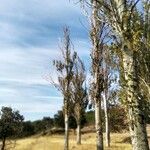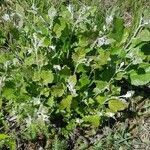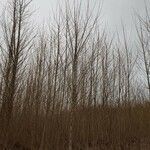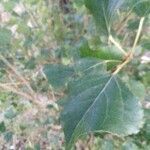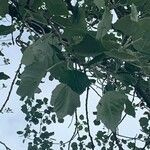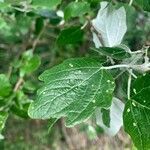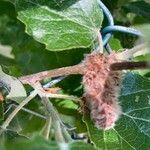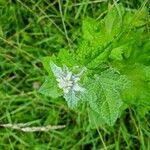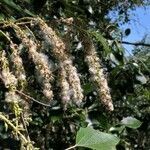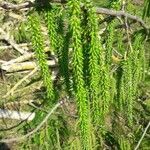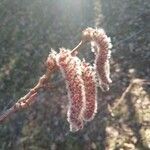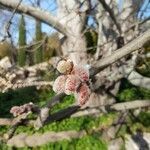Trees to 30 m tall, suckering freely; crown broad. Branchlets at first white tomentose; shoots grayish green or brownish, terete, densely white tomentose. Buds russet, ovoid, 4-5 mm, densely white tomentose, glabrescent, shiny. Leaves of short branchlets with petiole slightly flattened, ca. as long as leaf blade; leaf blade ovate-orbicular or elliptic-ovate, 4-8 × 2-5 cm, both surfaces tomentose. Leaves of sprouts and long shoots ovate-orbicular, middle lobe much larger than lateral ones, 4-10 × 3-8 cm, adaxially white tomentose at first, somewhat glabrescent, base broadly cuneate, rounded, truncate, or subcordate, palmately 3-5-lobed; margin irregularly notched; lateral lobes spreading nearly obtusely, entire or notched-lobed. Male catkin 3-6 cm. Male flower: stamens 8-10. Female catkin 5-10 cm. Female flower: stipe short; stigma 2-lobed. Capsule narrowly conical, ca. 5 mm, glabrous, 2-valved. Fl. Apr-May, fr. May.
Has been grown as an ornamental in Kenya: Navaisha District, Kitiri [Kitini], 17 Jan. 1955, D.G.B. Leakey H12/55!, said by collector to be spreading.. Tree to 30 m... Twigs, buds and petioles white-tomentose.. Immature leaves large, ovate, 3–5-lobed, coarsely toothed, 6–12 cm. long, width slightly less, mature leaves smaller, ovate-elliptical or oblong-elliptical, often wider than long, sinuate-dentate; both forms with ± acute apex, rounded or subcordate base, dark green above, densely white tomentose beneath.. Male inflorescence 6 cm. long or more; bracts broadly ovate or oblong; flowers crowded, sessile; disc entire, with undulate or shallowly irregularly lobed margin; stamens 6–10.. Female inflorescence similar but shorter; ovary narrowly ovoid, up to 1.5 mm. long, 1 mm. wide, stigmas 4, linear, 0.7–1 mm. long.. Capsule narrowly ovoid 2–3 mm. long.
Erect tree to c. 20 m; main branches (‘long shoots’) erect or the lower ones broadly spreading; ultimate branches (‘short shoots’) slow growing with very short internodes; bark smooth, pale grey, dark-fissured toward base with age. Leaves on long shoots triangular-ovate, to l2 cm long, palmately 3–5-lobed, thc lobes coarsely dentate, deep dull green above; petiole and lower surface of lamina densely white-woolly; leaves on short shoots ovate-elliptic, coarsely sinuately dentate, sometimes glabrescent beneath. Catkins nodding, purplish, 3.5–6 cm long, elongating in fruit; floral bracts shallowly few-dentate, hirsute on back. Stamens 6–10. Ovary stipitate; stigmas 2, each deeply bilobed. Fruit to c. 3 mm long, 2-valved.
A broad spreading tree. It grows to 20-30 m high. The bark is dark grey-green and cracked. The branches are twisted. The young shoots are covered with thick white felt. The leaves are alternate. The leaves are dark green with a silvery and downy underside. They are 10 cm long by 7.5 cm wide. They can be maple like with 3-5 lobes and a wavy or slightly lobed edge. Leaves turn yellow in autumn, then fall. The leaf stalks are flattened and flexible. The flowers are separately male and female on separate trees. They are catkins. Male flowers are crimson and female flowers are green. The plant produces many suckers.
Trees with whitish-gray bark and mostly widely spreading branches; terminal bud and young twigs tomentose; lvs white-tomentose beneath, palmately 3–7-lobed on long shoots, ovate and irregularly dentate on short ones; stamens 6–10; stigmas 2, bifid, filiform; fr narrowly ovoid, the pedicel 1–2 mm; seeds (1)2(3) per placenta; 2n=38, 57. Native of Eurasia, commonly planted, and occasionally escaped. A columnar form is cv. ‘Bolleana’ (P. bolleana)
Deciduous tree, up to 30 m high. Twigs, buds and underside of leaves white-tomentose. Catkins 80-100 mm long.
